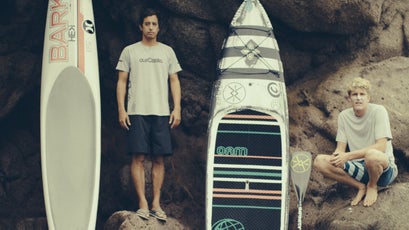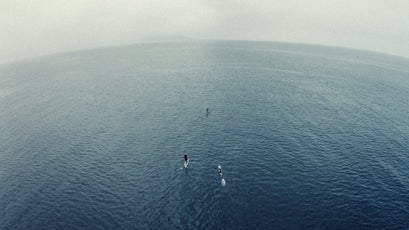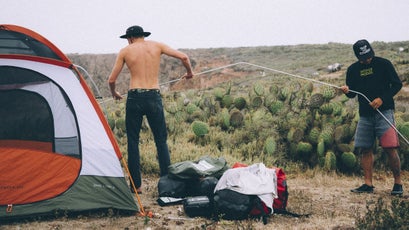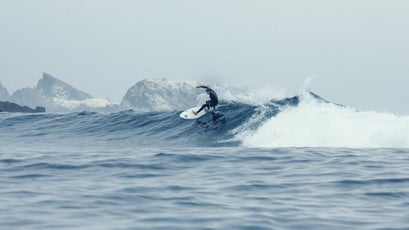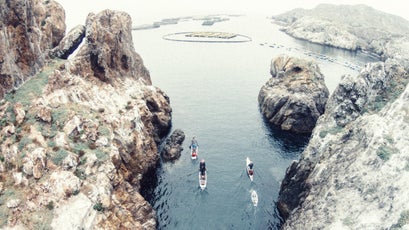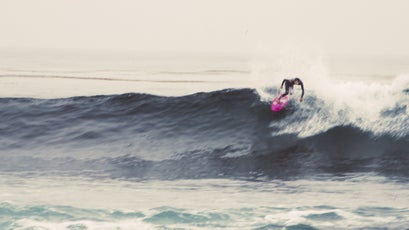Island of the Endless, Empty Waves
Want to find the crowd-free surf of yesteryear? Drive from Los Angeles to Baja, load five days of gear onto a SUP, and haul ass through thick fog, screaming seagulls, and open ocean to the rocky, big-wave coast of Todos Santos.
New perk: Easily find new routes and hidden gems, upcoming running events, and more near you. Your weekly Local Running Newsletter has everything you need to lace up! .
I’m pretty sure we’re going in circles. Visibility is 40 feet, and a thick gray mist hovers over the Pacific Ocean as our paddleboards part the eerie fog. We’re somewhere between the rugged, mountainous foothills of the Mexican mainland and Islas de Todos Santos, a desolate pair of islands eight miles off northern Baja’s shore. “That’s the same point we just paddled by,” says Jack Bark.
We thought this would be easy: the day before, Bark, Dave Boehne, and I drove 170 miles from Dana Point, California, to La Bufadora, Mexico, loaded our paddleboards with everything we could carry—shortboards for surfing, sleeping bags, tents, food—and headed out across the bay to Todos Santos for a long weekend of summer swell. Bark is on a traditional prone paddleboard, hand-paddled from the knees or while lying flat; Boehne and I are on SUPs. Why come all this way? Because while lifelong surfers like Bark, 21, and Boehne, 39, still paddle out into crowded lineups near their homes in the Los Angeles area, the sport’s population problem instills in them a common ethos: the search for emptiness.
Todos Santos (the islands, not the resort town farther south) is virtually deserted, even though it has a storied surfing history. The southern landmass is surrounded by nameless waves, but the northern island made Todos Santos famous. That’s where you’ll find Killers, a big-wave break that remains a proving ground as brave surfers charge 40-foot behemoths each winter.
While Killers inspires awe, the islands’ true geological gift to surfers is exposure. The points of land face the Pacific’s swells unencumbered year-round. In winter, massive waves pound in from the west and northwest; in summer, little-known breaks that are much less dangerous but just as high quality go off during Southern Hemisphere swells.
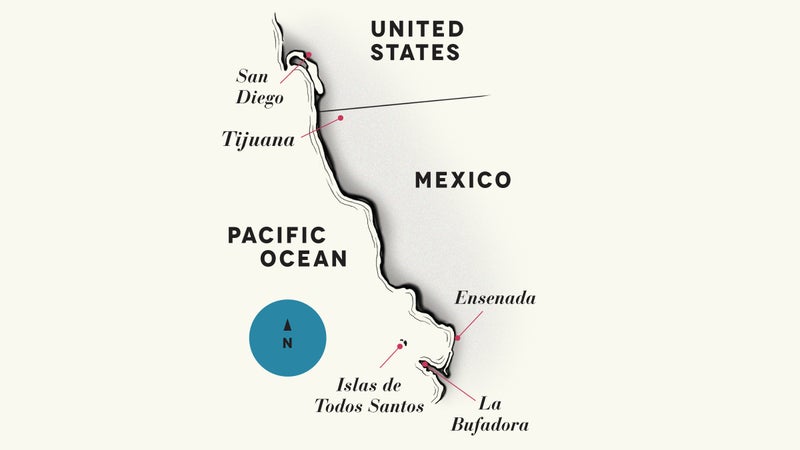
But first we have to get to them. Five hours in, we’re still on our boards in open water with no clue where we are.
“Somebody’s gotta take charge,” yells Boehne, his usually calm demeanor broken slightly by the frustration of paddling blindly in the fog. Bark, who has blond hair and the toned physique of a distance runner, looks at me in disappointment: “Does anyone even have a map?”
We don’t have a map. Or a compass. Or even a GPS. The navigation system was left in the van during the hustle to rig our boards that morning, amid the haze of a hangover—we’d got a little too wrapped up the night before at the local tequileria, celebrating our arrival. We’ve been planning the trip since last winter, when Boehne pitched it to me over beers in a crowded bar on the Pacific Coast Highway near Dana Point. He grew up visiting Todos Santos with his family, who went there to camp and ride waves. His parents, Steve and Barrie, are former world champions in tandem surfing, a largely forgotten art of lifts and poses—like figure skating on surf. They started in 1970 and used to load up their catamaran and sail everyone out to Todos Santos for days of surfing and exploring the rocky coastline.
Bark, meanwhile, grew up in Torrance, a suburb of L.A., sweeping the floors of the shaping room at the headquarters. His dad, Joe, has produced thousands of surfboards—big-wave guns, SUPs, and prone boards—since founding the business in 1982. Steve Boehne and Joe Bark were among the first to start handcrafting SUPs, around 2005, and Joe is one of the few still shaping prone boards.
Both Jack and Dave are gifted ocean athletes, so instead of a sailboat, panga, or anything remotely convenient, we decided to haul our gear over the open ocean on paddleboards, which we could then use to explore and surf once we reached the islands.
Around 12 feet long, the hand-powered prone board is older than American surfing. Tom Blake, credited with developing California surf culture, reinvigorated the obscure Hawaiian olo board in the late 1920s, constructing his hollow version from redwood and promoting it as a lifeguarding tool. While the boards remained somewhat popular in Australia and along the East Coast, in California they were confined to a few races, like the International Paddleboard Competition (now called the), from Catalina Island to the mainland.
Then came the stand-up paddleboard’s popularity, credited to its adoption by Laird Hamilton in the early 2000s. Around 2010, prone paddling experienced a resurgence as athletes like Jamie Mitchell, who won ten straight titles, and young paddlers like Bark and Queensland’s Jordan Mercer, who’ve each won multiple Molokai races, provided the sport with new life. “Stand-up paddling’s boom has brought a lot of visibility back to prone boards,” Bark says. Many of today’s SUPs borrow traits from traditional prone designs—rail lines, displacement noses, domed decks.
Bark and Boehne have taken to the family business. When he’s not in environmental-science classes at California State University at Dominguez Hills, Bark works alongside his father to fill custom board orders and manages the brand’s social-media accounts. Boehne grew up doing pretty much everything at Infinity—from answering phones to board design to marketing. “I shape boards. Jack shapes boards,” says Boehne. “Riding our bikes over the hill at lunch to check the surf was a big part of both of our families’ business plans.”
After circling for hours, arguing over which way the swell is moving, we finally hear ocean water hitting coastline through the dense fog and paddle until we reach land. We drop our gear on the north island’s protected side and bivouac above a tiny cove. I build a small fire to make tacos while Bark and Boehne drink warm Tecates and devour tortilla chips.
With our blood sugar levels back up, we spend the next three days exploring the islands. We pick our way through the rocks on our boards, touring hidden caves tucked into pristine coves where surprised elephant seals bark loudly as we paddle by, flopping toward the water in panic. “Hold up,” says Bark. “I wanna jump out of that cave.” He points to a small nook 20 feet off the water, quickly climbs the scree-strewn slope, and launches into the deep salt water.
We comb the rocky point where Killers terminates in the winter, and thousands of seagulls try to dismember us for plodding among their nests. In the brush, we find a broken Bark board, a battered remnant of heavy winters past. “It was one of my buddies’, ” Bark says, recognizing the orange and red design. Bark’s friend surfed it here two years before, destroyed it on an exceptionally big wave and relayed the death-defying tale upon his return.
The surf we ride isn’t quite as huge—waves rarely reach seven feet—but it is everywhere. Of our three options, the break in the channel off the north point of the south island has the best shape. The wind is nil, and the water is glassy. The peak looks like it should be a left, only the left fattens out; the right reels toward the point and culminates thunderously on the inside. Bark paddles into the first wave on his shortboard and makes a nice top turn. “This is so sick,” he says, paddling back out to our lonely lineup.
Boehne is all style. His tan skin and hair work together to highlight his white smile. “This is what we’re after,” he says as the waves come in. He takes off, gets over his board, lowers his center of gravity in a compact stance, and coils up to hit the lip. But the wave dissipates, and he carves on his forehand back to the white pile, snapping off the top on the rebound. He returns to our lineup of three as Bark takes off on the next wave. “A little overhead on sets and no one around,” says Boehne. “I don’t think anyone in the world would complain about that.”
Joe Carberry is the founding editor of SUP magazine and a columnist for Sports Illustrated. This is his first ���ϳԹ��� feature.



